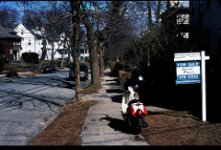Roger Hicks
Veteran
Dear Godfrey,I've had a few of the Fujis (GS645, GS645W, GA645), a brace of the Zeiss Ikon Super Ikontas (645, 6x6, 6x9 models, can't remember the designations), a Balda Baldax (scale focus), and a Voigtländer Perkeo II (scale focus) over the past 25 years. All are gone now except the Perkeo II, for which I found a nice clip-on Voigtländer rangefinder (as well as a couple of others!).
The Perkeo II has been my favorite MF compact/folder for some years now. It has an excellent lens and folds up very small and light, with a quality feel that is the equal of the Super Ikontas but much lighter. I had it overhauled (cleaned, a couple of rusty bits replaced, etc) a few years back to solve some minor issues with the film transport, so it now feels like a new camera. The lack of a coupled rangefinder means it's a bit slower working, but it also means it's likely a bit more reliable.
I think I paid $125 for the Perkeo II when I got it, but the overhaul cost about $170. That's not too bad for an EXC+ camera now sixty-five years old with this level of quality.
info: http://camerapedia.wikia.com/wiki/Voigtländer_Perkeo_II
G
Indeed, I prefer the quality of top-of-the-line Voigtlanders to similar Zeiss cameras. As I say in the piece referenced (and now linked) above,
But then, Voigtlander Bessas (I, no rangefinder, II, rangefinder) are nowadays very expensive too, though they are even better made and are usually equipped with even better lenses. I'd rather have a 1950s Bessa myself.
I have a Bessa I with a beautiful, sparkling-clean 105/3.5 Color Skopar in a Prontor SV, but it has a most improbable defect: no pressure plate! I didn't notice when I bought it (for 15€ at a vide-grenier) because who, after all, manages to lose a pressure plate? Ever since, I've been looking for a scrapper to serve as a donor. Years ago, someone kindly sent me a pattern for cutting a new pressure plate but I decided that my metal-working skills weren't up to it.
It's also missing the 645 mask but I don't really care (and wouldn't care it it were working, either) because for me, most of the reason for roll-film is the tonality and bigger is better. Also, with front-cell focusing on a Tessar-type lens, I've always found that 645 is pushing your luck a bit at full aperture.
Note to OP: BEWARE of 620 cameras (same film, smaller metal spool). Some are happy rewinding 120 onto 620 spools but I've always found it more trouble than it's worth.
Cheers,
R.


